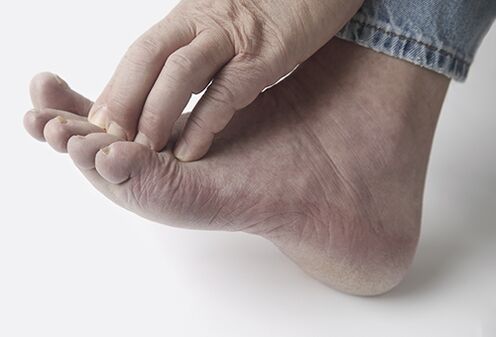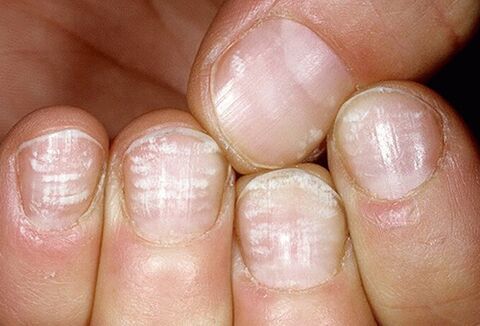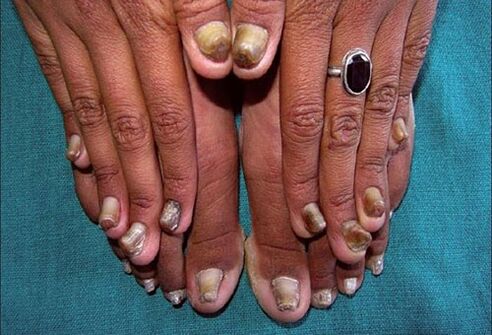Nail fungus should not be confused with anything in its advanced stage, when it is almost impossible to cure. But if you know the previous symptoms of nail fungus, it is not too late to start fighting the infection and losing your nails can be avoided. But in different cases, the fungus looks different, so you must first understand a little about the nature and course of the disease.

General signs of the disease
Regardless of the type and variety of the fungus, the course and even the stage of the disease, these symptoms remain unchanged and certainly indicate an onychomycosis that is developing or already developing.
- The change in the color of the nail plate is a key sign from which the disease develops. Shades can range from whitish to black, but the most common color for fungal nails is brownish yellow.
- An unpleasant odor always accompanies onychomycosis, although it is not very noticeable in the initial stages. True, it hardly smells at your feet, and already at the stage of the development of the disease you will notice a peculiar smell.
- The layering, crumbling, and peeling of the nail plate does not begin immediately, but most people are alarmed by these signs of the nail fungus. If these symptoms are moderate and occur locally, there is still a chance of the nail appearing healthy.
- Painful feelings rarely occur in the initial and developmental stages, but as the disease progresses, discomfort and pain cannot be avoided: in all cases, it is due to either a deformity, a broken nail plate, or a nail plate. onset of purulent inflammation.
- Burning and itching of the skin should not be ignored either. Moreover, in the initial stage, these symptoms can help to recognize the disease because in some cases it passes from the skin to the nail plate through the side or back ribs or cuticles.
By the way
Onychomycosis is much more common on the toenails, while the fungus is much less common, most commonly after contact with the affected toenails.

Symptoms of foot fungus
You may already know how to identify a fungus, but this information is fairly general, although it helps to accurately diagnose onychomycosis. The fact that it can cause more than 50 species of fungi and the course of the disease is about 10. It is better to know in advance what awaits you in each of the possible scenarios.
More than 90% of onychomycotic infections in the legs are caused by dermatomycetes, slightly less than 10% by yeast-like fungi, and only a small proportion by molds.
Different types of nail fungus cause different symptoms.
- In the case of a normotrophic fungus, the nail plate itself is not deformed, and the most conspicuous manifestation of the disease is a change in the lateral color of the plate to yellowish brown. At the same time, its thickness does not change, it does not crumble, and its natural shine does not disappear. If you do not deal with the treatment of the normotrophic fungus, it will affect an increasing area, the plate will start to peel off and will peel off completely.
- The hypertrophic fungus causes the nail plate to thicken, leading to the appearance of growths that look like claws. At an advanced stage, such a fungus causes discomfort, often pain while walking, and, of course, damage to the nail with a grayish or yellowish discoloration. Such nails lose their natural shine and begin to crumble and peel.
- If you are exposed to atrophic fungi, the risk of losing the plate without proper treatment is extremely high. Such a fungus gradually destroys the nail plate, making it loose and peeling, resulting in atrophy. In the initial stage, it is difficult to distinguish the atrophic course because it only results in the loss of luster and the change in color of the plate to yellow, brown, or gray.
Less characteristic is lateral-distal mold with blackening of the nail plate, pain, suppression and atrophy of the nail plate in the advanced stage; proximal fungus with white spots in the area of the growth zone and damage to the nail plate from the side of the cuticle, and a white superficial fungus that manifests as small white spots on the skin. nails, gradually growing and occupying a larger area.
By the way
The older a person is, the more susceptible they are to fungal nail diseases. The occurrence of the fungus can be affected by climate, hygiene and sex.

Symptoms of the fungus on the hand
In the hands, the 3 main variants of the course of the disease do not differ from those seen in the legs, only the distribution of the causes of occurrence differs slightly: approximately 30% and 45% are of dermatomycetes and yeast-like origin. fungi, slightly less than 15% are molds, and some infections are caused by other fungal organisms.
The main symptoms are the same for the plates on the arms and legs, and the affected areas are similar. The only difficult point may be how to detect nail fungus less frequently, such as rubromycosis or trichophyton infection, but this is more the job of qualified doctors.

Fungal progression
If at the initial stage the disease does not seem frightening and the thoughts of serious treatment are rare, they are increasingly being replaced by folk methods, then at an advanced stage it cannot be done without long-term medical treatment. And even that can’t guarantee that your nails will stay with you.
- It would be ideal to start treatment for the disease at an early stage, but it is almost impossible to determine outside the laboratory: all symptoms have a barely perceptible manifestation. Although a sign or two is still visible. If you notice anything defective on your skin, such as cracks, blisters, or burns, it is a clear harbinger of onychomycosis of your nails. If you see that the color of the nail plate has changed along the edges or starting from one of the edges, this is also a cause for concern.
- Usually, the fungus becomes noticeable as early as the stage of development, and in order to notice it as early as possible, you should perform at least one simple pedicure on a regular basis and monitor the condition of the skin of your nails and feet. During this period, the nail plate appears unhealthy, loses its shine, a significant color change begins, and closer to the beginning of the advanced stage, the nail becomes deformed, detached, and crumbled.
- At an advanced stage, the nail definitely collapses actively: it comes off, breaks off, loosens until the nail plate is completely destroyed and even the nail bed is damaged. In order for the disease to reach its advanced form, it must be ignored for a long enough time, itching, discomfort, disgusting appearance, and unpleasant odor, which people still do not do. Therefore, this stage is characterized by the rapid development of the fungus in old age or in the presence of certain diseases.
It is important to note that untreated nail fungus can turn into foot fungus, and this disease is even more unpleasant and difficult to treat.
It is not so difficult to determine the presence of a fungus on nails at least during the developmental stage, but it is better to have trained professionals determine the cause and type of course. Do not ignore the help of doctors and contact them if you have the first suspicion of the disease.
























